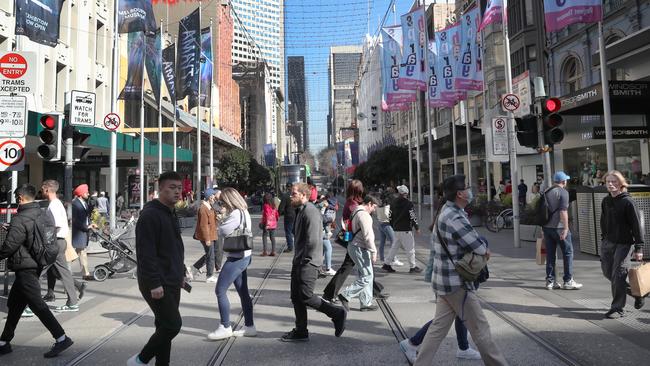The number of Australians in work increased by a bumper 64,000
There are more Australians in work than ever, with the employment to population ratio climbing to a record 64.5 per cent.

The Reserve Bank looks set to continue to hike rates in the new year after figures showed a record number of Australians in work following another bumper month of jobs growth.
The Australian Bureau of Statistics’ data revealed employment jumped by 64,000 – more than twice the number anticipated by economists – as the unemployment rate held steady at 3.4 per cent, the lowest since 1974.
Jim Chalmers on Thursday welcomed the strong jobs report, but foreshadowed a more difficult 2023.
“We know Australia won’t be immune to the volatile global economic environment driving higher global inflation and slowing growth,” the Treasurer said.
“International developments and cost-of-living pressures will inevitably have an impact on our economy and labour market.”
With this year’s jobs boom showing no sign of waning, analysts said it was further evidence the RBA would have to continue to lift rates in the new year to slow demand and bring inflation under control.
Underemployment, which measures those with jobs but who are looking for more hours, fell from 6 per cent to 5.8 per cent. Full-time employment accounted for more than half the total monthly increase, lifting by 34,200.
KPMG chief economist Brendan Rynne said: “The implications of these very healthy employment numbers is that aggregate demand and household spending in Australia will continue to remain elevated simply due to the weight of income being earned across the population.
“This will ensure the RBA enters 2023 with a keen eye to maintaining the contractionary path for the cash rate.”
Dr Rynne predicted a further hike to 3.35 per cent when the RBA board next meets in February, with the prospect of more rises to follow.
More Australians than ever were in work, with the employment to population ratio climbing to a record 64.5 per cent.
The under-utilisation rate, which combines unemployment and underemployment measures, fell 0.1ppt to 9.3 per cent – the lowest rate since February 1982, the ABS said.
The jobless rate was unchanged because of a lift in people in the workforce as the participation rate climbed by 0.2 percentage points to 66.8 per cent.
ABS head of labour statistics Bjorn Jarvis said the record high participation rate continued to show it was a tight labour market.
Mr Jarvis said the low under-utilisation rate “reflects the fact that there are now around 221,000 fewer unemployed people and 370,000 fewer underemployed people than in March 2020”.
“Unemployment and underemployment are both now around two thirds of what they were,” he said.
NSW led the jobs growth, while the mining states Queensland and Western Australia had the weakest increases.
Citi economist Faraz Syed said even a big increase in immigration would not be enough to end worker shortages.
“The overall increase in the labour force participation rate suggests that the recent uptick in net overseas migration is within the working age population cohort that is easily able to find a job in an extremely tight labour market,” Mr Syed said.
The key jobless measure has hovered about 3.5 per cent since the middle of this year and is at its lowest level since 1974, following a recovery supercharged by government spending and extraordinary monetary policy measures.






To join the conversation, please log in. Don't have an account? Register
Join the conversation, you are commenting as Logout